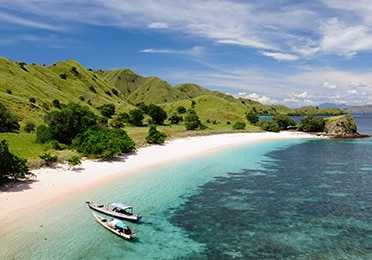Unspoilt beauty lies at the west end of the fabled island of Bali: lush green forests, picturesque mountain range, crystal clear blue water, and vast stretches of pristine beaches, those are what await at the West Bali National Park. Home to over a hundred species of wildlife, the national park is best known as the sanctuary of the exotic white Bali Starling , an endemic iconic bird of the island of the gods.
Located in the most north-westerly point of Bali, the national park includes the whole area of the Prapat Agung Peninsula, and large swathes of land around the towns of Gilimanuk, Cekik and Banyuwedang which lie in the regencies of Jembrana and Buleleng. This national park is approximately 100Km from Bali’s capital city, Denpasar, or about 50 km west from the northern city of Singaraja, capital of Buleleng regency.
West Bali National Park has a total area of 19,002.89 hectares, covering 15,587.89 hectares of land and 3,415 hectares of water. The habitat is very varied with rainforests, dry savannas, acacia scrubs and lowland forests, as well as more montane forests in the higher region. There are also some pockets of dense mangrove forests. In the north of the park is an obvious north jutting peninsula called Prapat Agung. Around this peninsula are long stretches of protected beach and offshore coral reefs as well as a small offshore island called Menjangan . The latter is a very popular diving destination.
One hundred and sixty species of birds have been recorded in the park, including the near extinct Bali Starling (Leucopsar rothschildi), Bali's only endemic vertebrate species,the fauna icon of Bali. It was the key reason why this national park was created in 1941. By 2001, it was estimated that as few as only six individual starlings were thought to have survived in the wild, all of them in this park. Since then, captive breeding and re-introduction efforts have continued apace, but poaching pressures remain a large problem. With that in mind, a second re-introduction program was started in the remote regions of Nusa Penida, off the coast of Sanur Beach in 2004. In June 2011, West Bali National Park received 60 endangered Bali Starling for release, 40 from the Surabaya Zoo and 20 from Taman Safari Indonesia . Keen birdwatchers can find a checklist of likely species and their status here.
Among some other fauna found in the National park are: the Wild Bull ( Banteng), Barn Swallow, Black-naped Oriole, Black Racket-tailed Treepie, Crested Serpent-eagle, Crested Treeswift, Dollarbird, Hawksbill Turtle, Indian Muntjac, Java Sparrow, Javan macaque (Lutung), Large Flying Fox, Leopard Cat, Lesser Adjutant, Long-tailed Shrike, Milky Stork, Pacific Swallow, Red-rumped Swallow, Menjangan Wild Deer, Sacred Kingfisher, Savanna Nightjar, Stork-billed Kingfisher, Water Monitor, Wild Boar, Yellow-vented Bulbul, and many more.
The national park is also the home of several endangered species of flora such as: Pterospermum diversifolium, Antidesma bunius, Lagerstroemia speciosa, Steleochocarpus burahol, Santalum album, Aleuritas moluccana, Sterculia foetida, Schleichera oleosa, Dipterocarpus hasseltii, Garcinia dulcis, Alstonia scholaris, Manilkara kauki, Dalbergia latifolia and Cassia fistula.
The Marine reserve includes the cape shores and several sanctuary islands with many seabirds in the bay of Gilimanuk, on the island of Menjangan and the excellent coral reefs surrounding it. The good drop-offs on Menjangan's south side are only surpassed by the particularly superb reefs on its northern shores. The island is a popular spot for locals and tourists wishing to dive for a variety of fish and coral reef exploration. There are no dangerous currents to contend with in this area.
West Bali Barat National Park also shows high bio-diversity in a relatively small marine area. At the end of the last century, 110 species of corals belonging to 18 families were recorded, of which 22 species were of the mushroom coral family (there are only 29 species of mushroom corals recorded worldwide), and there were at least 27 species of Acropora coral found in a relatively small area of only 2 hectares.
With all the splendors that stretch from the heart of its thick jungle to the deep waters that surround the peninsula, West Bali National Park is truly a natural treasure of the fabled island of Bali.
For permit and information please contact:
West Bali National Park Head Office:
Balai Taman Nasional Bali Barat
Jl. Raya Cekik-Gilimanuk Jembrana, BALI 82253
Phone: +62 365 61060
Fax: +62 365 61479
E-mail: tnbb09@gmail.com
Website: www.tnbalibarat.com
Get There
Most visitors to the park arrive along the north coast road from Lovina (about 90 minutes) or Pemuteran (about 15 minutes). Others come from the south via Gilimanuk harbor which is the main port that connects Java with Bali (about 15 minutes). From the capital city of Denpasar, the trip will take roughly about 4 to 5 hours along the main west road that connects Denpasar to Gilimanuk.
All visitors should check in at one of the two park offices (PHPA) for information, and to obtain permits and arrange guides. The headquarters is at the village of Cekik just south of Gilimanuk in the west. The other is at Labuan Lalang on the north coast from where boats to Menjangan Island depart. The main ranger station is on the road between the two offices at Sumber Klampok.


















